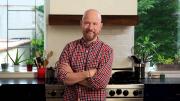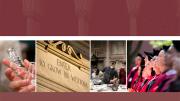It sounds odd—quite odd, actually—for a sandwich. Two slices of sourdough bread emerge from a toaster, then one gets slathered with peanut butter. Nothing surprising so far. But then a layer of pickle chips covers the nut butter, followed by a drizzle of soy sauce and one of sriracha, the Vietnamese spicy condiment laced with chili pepper. Top with the other slice of toast and take a bite. Then the surprise. The briny, vinegary pickles’ crunch contrasts splendidly with the sweet, creamy nut butter. Soy and sriracha sauces add edge, and toast makes the perfect foil. An original, stimulating sandwich.
It’s simply a spin on “a great old sandwich of the American South: peanut butter and pickle,” writes Sam Sifton ’88 in The New York Times Cooking No-Recipe Recipes, his new book with an oxymoronic title and alluring photographs. “No recipe” dishes like this one have been a Wednesday staple of Sifton’s newsletters that go four times weekly to subscribers to New York Times Cooking, the newspaper’s digital cookbook and cooking website that Sifton founded in 2015. No-recipe recipes give lists of ingredients (substitutions encouraged), but no measurements, and accompanying texts that read more like chatty suggestions from a fellow cook than orders from a head chef. “It’s conversational,” he says. “Like a dialogue between two people who know what they are talking about—me and a reader who can act on a prompt.”
Traditional cookbook recipes “are like sheet music,” Sifton explains, “follow the directions and you can play passable versions of, say, Beatles’ songs. No-recipes are not bossy. They’re more like a chord chart. They lay out a structure to follow, but you can jazz it up as much as you want.” For example, the lack of a specific amount of sriracha in that sandwich lets the home cook either make a mild version or pour it on, since, of course, some like it hot.
Sifton has worked in a restaurant kitchen and was the Times restaurant critic for a couple of years, but he makes no pretension to being a chef. “I show you ideas for cool stuff you can do,” he says. “I don’t develop new recipes. I listen to chefs and talk to people and figure out how to make stuff. Chefs are poor recipe writers for civilians. They speak with each other in a kind of shorthand. But they can tell you how to make what they cook—listen carefully, and you’ll have a good day.”
“Sam has a broad, inclusive view of food and cooking,” says writer and editor John “Doc” Willoughby ’70, co-author of numerous cookbooks and former executive editor of Gourmet magazine. “That, plus his incredible hard work, excellent taste, and eye for talent have turned The New York Times Cooking site into a modern Joy of Cooking, the first stop for many of us when looking for recipes. But his newsletter and his new book can also help readers cook without a set recipe. That’s really the goal for most of us, and it’s the most creative and satisfying way to make a meal in your own kitchen.”
The COVID-19 pandemic “may have changed the way we think about home cooking forever,” says Sifton. The shutdown of restaurants has meant that “Many of us have spent 15 months cooking at home three times a day, seven days a week. So we’re more confident in the kitchen—it’s not a big deal to roast a chicken or make a pot of beans. With that muscle built, we’re not going to let it atrophy.”
That comes atop the explosion of interest in food and drink that has rolled on for decades now. As the founder of New York Times Cooking and someone who has been immersed in food culture his entire life, Sifton is certainly in the right place at the right time. His home in Brooklyn has a spacious kitchen dominated by a large island that looks ready to be the set for a cooking video at a moment’s notice.
“Since the end of World War II, the food industry in the United States has continued to build,” he explains. “The booming postwar economy and women going into the workforce set the stage. Mass media fueled the desire for excellent food with television series like Julia Child’s The French Chef, Yan Can Cook, and The Galloping Gourmet. Later, the Food Network and the Cooking Channel amplified it to a kind of maniacal degree.” (But Sifton has no use for the term “foodie,” which he calls “infantilizing. People who like going to galleries and looking at paintings aren’t called ‘arties.’ People who enjoy chamber music are not labeled with some nickname that depreciates their interest.”)
“Watching food TV is kind of a busman’s holiday for me,” he admits, but he does admire Food Network’s Guy Fieri, who has hosted several series, including Diners, Drive-Ins and Dives. “He’s done so much to democratize the excellence of food in America,” says Sifton. “He takes people around the country and shows them the incredible diversity of mom-and-pop, small-business restaurateurs. And I love the fact of regional cooking—things that are specific to a place. Journalism can help preserve that.”
Regional and even world cuisine have now arrived in local food outlets. “The American supermarket has gotten a lot better as the U.S. consumer finally started to welcome a diverse pantry and a diverse market to supply it,” he says. “Thirty years ago, you would never find an ingredient like lemongrass at a Publix supermarket in Fort Myers, Florida. Now you can.”
Yet it hasn’t been just an unending smor gasbord of delights. “There was a weird sexist double-reverse move,” Sifton says. “Male chefs previously had been blue-collar workers behind kitchen doors. Television brought them out in front of the kitchen doors to become celebrities who were aped by other men. When men started cooking and trying to make the recipes of their rock-star heroes, all of a sudden people were saying, ‘Wow! There’s this huge cultural juggernaut!’ Meanwhile, women would tell you, ‘Actually, food has been a big deal in the United States for a long time. You’re just beginning to notice it now.’”
Worldly as he is, Sifton remains firmly rooted in place. Born in Brooklyn, he has spent most of his adult life there,and now lives in the Red Hook neighborhood. Father Charles P. Sifton ’57 was a federal judge in New York’s Eastern District. His mother, author and book editor Elisabeth Niebuhr Sifton ’60, was the daughter of theologians Reinhold and Ursula Niebuhr. She shepherded many works of “literary lions” into print, such as Don DeLillo and Carlos Fuentes.
Sifton’s mom also collected recipes from The New York Times and Gourmet in three-ring binders. Like many women of her generation, “She was deeply influenced by Julia Child,” Sifton recalls. “She cooked ambitiously, and a lot. Perhaps more adventurously than three young boys [Sifton and his younger brothers, Toby and John] would have liked. Baked fish with black olives and orange slices was a mighty mountain to cross for 10-year-old boys!”
Judge Sifton was a pretty good cook himself, and on Saturdays the family traversed New York City, seeking pantry supplies: Manhattan’s German neighborhood of Yorkville for ham and sausages, Little Italy for bread and different kinds of sausages, and deep into Brooklyn for a special brand of ginger beer. “I don’t know if those expeditions made me a cook,” Sifton recalls. “But they made me a New Yorker, and set me up for a life in food.”
At Harvard, he soon fell in with a group of students connected to history and literature, his eventual concentration. One of them tended bar at the Harvest, a stylish restaurant serving modern New England fare that’s still thriving in Harvard Square. “It seemed glamourous—tending bar, tips galore, cash, adrenaline—it felt so exciting!” Sifton says.
He got a job there that was “the opposite of glamourous—cashier at lunch,” he recalls. The cashier post doubled as the coffee station, and “we ‘pulled coffees,’” he says. “The highlight of which was when I made a cappuccino for Julia Child—and she liked it!” He’d also pour quadruple espressos over ice for the cooks in chef’s whites who streamed in at midday to do prep work for the dinner service. “I didn’t know what they were doing,” he remembers, “but it seemed amazing.
“I was reading history and literature at a big table in Widener,” he continues. “The Harvest kitchen was the complete opposite—loud, chaotic, exciting. With all the flamed stuff it seemed a little dangerous. I wanted in on that.” He talked his way into doing prep work like peeling vegetables in the kitchen, along with ministering to cold foods such as salads and cheese plates. He also worked the grill. “It was terrific!” he says.
Sifton had always wanted to be a journalist, but didn’t comp the Crimson as an undergraduate. At the time, Joe Kahn ’87, A.M. ‘90, was Crimson president, and Sifton recalls thinking, “I don’t need to work for him now.” Twenty-five years later, Kahn is managing editor of the Times, so “I work for him,” Sifton says, with a laugh.
Soon after graduation, he moved to New York for a job with American Heritage magazine, then taught social studies at Bushwick High School in Brooklyn for four years. Sifton also started to enjoy reading a “contrarian, funny, borderline irresponsible” free alternative weekly called the New York Press, which published from 1988 until 2011. He crafted a “detailed, caustic, and wry” submission for the weekly’s annual, unconventional reader poll, and editors Russ Smith and John Strausbaugh offered him a gig writing about food.
He ended up staying there for 10 years, rising to managing editor by the end. Then, editor Tina Brown recruited Sifton for the staff of her ill-fated, $50-million startup magazine, Talk. He stayed for three years as a senior writer and editor until it folded. In 2002, Sifton finally landed at The New York Times and has been there since. Sifton joined the paper’s Dining desk, then moved to the Culture desk as editor of arts coverage. Next, he spent two years as restaurant critic. “It’s hard to complain about that job,” he says. “You eat out a lot—critics eat at least three meals at places they review—so it’s important to exercise. It’s a night job, so when the kids were small [he and his wife, theater producer Tina Fallon, have two children] our family dinner was a hot breakfast—even if I had to be in sunglasses, palming an Advil.”
Next, Sifton shifted into a new role as the paper’s national news editor, where he ran 13 news bureaus around the country. In 2015 he returned to the Food desk to launch New York Times Cooking, a business based at the newspaper but separate from the core news operation. Last year he became an assistant managing editor in charge of overseeing all of the paper’s culture and lifestyle coverage, embracing the arts, food, books, style, real estate, travel, and Well, a personal health and wellness section.
“Even if you are making some crazy dish out of what you have in the pantry, you should have confidence in yourself.”
Sifton has also written two other cookbooks: Thanksgiving: How to Cook It Well (2012) and See You on Sunday: A Cookbook for Family and Friends (2019), an homage to classics of the “Sunday dinner” tradition—both regular cookbooks with recipes and clear instructions. “I can’t help but be a little bossy,” Sifton explains. “Even if you are making some crazy dish out of what you have in the pantry, you should have confidence in yourself. But if you don’t, listen to me and I’ll take you through it. I want to leave the reader with the idea that everything is going to be OK.”








